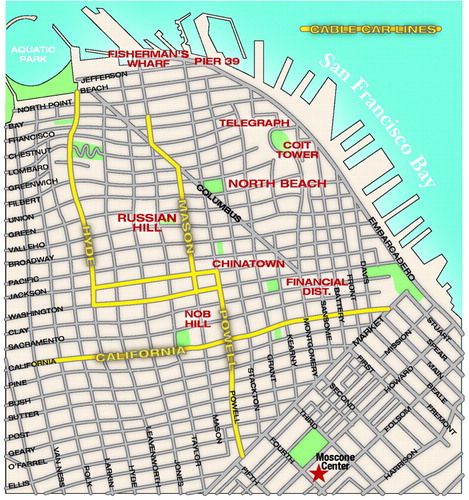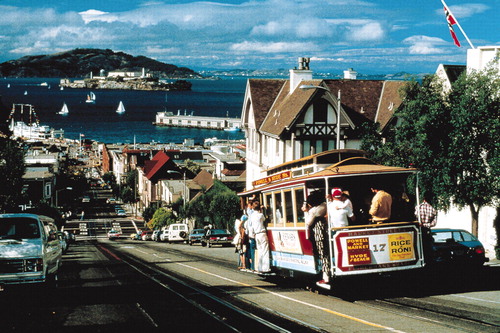Cable Cars: San Francisco’s Famous Thrill Ride
 Mention the words cable cars and people automatically think about San Francisco, where they were invented and, more surprisingly, are still traveling up and down those steep hills.
Mention the words cable cars and people automatically think about San Francisco, where they were invented and, more surprisingly, are still traveling up and down those steep hills.
As the story goes, London-born engineer Andrew Hallidie, who moved to San Francisco in 1852, was inspired to replace horse-drawn streetcars after watching five overworked horses plunge to their deaths in 1869 trying to drag a streetcar up a San Francisco hill, according to the San Francisco Cable Car Web site. He adapted technology he had perfected during the Gold Rush era to carry ore out of mines.
In 1873 Hallidie tested the first cable car system near the top of Nob Hill at Clay and Jones Streets. It worked, and about a month later the Clay Street line opened to the public.
Cable cars were soon operating on other San Francisco streets. The system was replicated in Chicago and as far away as Dunedie, New Zealand.
Each car weighs 6 tons and runs along a steel cable, enclosed under the street in a center rail. An operator pulls a heavy lever that applies a vise-like grip on the cable, which runs at a constant speed of 9.5 miles per hour. The brakes—not surprisingly, an avid interest of many first-time riders in light of the cars’ breathtaking ascents and descents—come in sets of three. A lever in the front of the car operates the main track brakes, while a foot pedal controls the front-wheel brakes, and a crank at the back of the car operates the rear-wheel brakes.
 San Francisco’s cable system is the only one in the world to endure to the present day. Thanks is largely due to the efforts of the Citizen’s Committee to Save the Cable Cars. In 1947 the mayor planned to close down the cable car system. When committee members heard of the mayor’s plan, they rallied the citizens of San Francisco to cast their votes for an amendment to save the cable cars. The amendment, which passed easily, required a majority vote of the city’s citizens before the cable car system could be closed down in the future.
San Francisco’s cable system is the only one in the world to endure to the present day. Thanks is largely due to the efforts of the Citizen’s Committee to Save the Cable Cars. In 1947 the mayor planned to close down the cable car system. When committee members heard of the mayor’s plan, they rallied the citizens of San Francisco to cast their votes for an amendment to save the cable cars. The amendment, which passed easily, required a majority vote of the city’s citizens before the cable car system could be closed down in the future.
In 1964 the cable car system was designated an official National Historic Landmark, according to the Web site.
Today, three of the eight original cable car street lines still operate. The Powell-Hyde and Powell-Mason lines begin at Powell and Market streets, an easy walk from the Moscone Center. The former carries riders past the mansions on Nob Hill, then climbs Russian Hill, and ends at Aquatic Park near Ghiradelli Square. The Powell-Mason line also climbs Nob Hill, but veers off to its terminus at Fisherman’s Wharf.
The California Street line, which has been grinding its way up the city’s hills since 1878, begins at the foot of Market Street, near the Embarcadero. It then traverses the Financial District and Chinatown, crosses Nob Hill, and ends at Van Ness Avenue.
Tickets to ride the cable cars can be bought at the turnarounds or from the conductor aboard the car. Fares are $2 each way, though senior citizens and disabled persons are charged $1 from 9 p.m. till 7 a.m. Children aged 4 and younger ride free. A $6 one-day “passport” allows riders to use cable cars, Muni buses, and streetcars. Riders can board at the turnarounds or anywhere signs indicate a cable-car stop.
In fact, San Francisco’s cable cars are such a must-see—or must-ride—attraction that they have their own museum. Visitors who are mystified at how the cable cars can drag themselves up those steep hills and then navigate safely down again can find answers to those and many other questions about those moving monuments to San Francisco history at the Cable Car Museum, which offers an observation gallery for a close-up view of exposed cables and the machinery that pull the cable cars. The Barn and Powerhouse, which can also be visited at 1201 Mason Street, is used for the storage and repair of the city’s cable car system.
On display are some of the earliest cable cars.
Additional information about San Francisco’s cable cars, including their history, routes, and a rider’s guide, is posted on the Web at www.sfcablecar.com. ▪



